






France's Nuclear Weapons
Development of the French Arsenal
De Gaulle ... replied to one strategist who had sent him a copy of his latest book that the analysis was all very interesting, but there was but one issue:
Est-ce que la France restera la France?
(Will France still be France?)
|
|
Quoted in The Evolution of Nuclear Strategy, Second Edition, by Lawrence Freedman, pp. 320, International Institute of Strategic Studies
|
Last changed 1 May 2001
AN-11 Bomb
This free fall bomb was the first nuclear weapon stockpiled by France, going into service in 1964. It was a pure fission plutonium implosion design, a development version of which was fired in France's first nuclear test on 13 February 1960. A prototype bomb was first tested 1 May 1962. The bomb was intended for high altitude delivery against strategic targets by France's first strategic nuclear bomber - the Mirage IVA (entered service October 1964). A live drop from a Mirage IVA was conducted 19 July 1966. The bomb weighed 1500 kg, and had a yield of 60 kt. The bomb was stockpiled from 1963, when full-scale production commenced, to November 1968. About 40 were built. Replacement by the AN-22 began in 1967.
AN-22 Bomb
This bomb replaced the AN-11, which it resembles in most respects. It was a pure fission plutonium bomb, originally weighing 1400-1500 kg, with a yield of 60-70 kt, intended for free-fall delivery from Mirage IVA bombers. It went into service in late 1967 and was retired July 1988. The bomb had improved safety features. Modifications while in service reduced its weight by half (with yield unchanged) and equipped it with a retarding parachute for low-level delivery. About 40 bombs were built, one for each of the 36 Mirage IVA aircraft in service. As the Mirage IVAs were retired in the late eighties so were their bombs. The last squadron retired 1 July 1988.
MR-31 Warhead
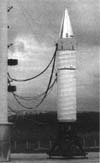 |
| SSBS S3 Missile |
This missile warhead was in the stockpile from 1970 to June 1980. It was test fired 11 September 1966. It armed the SSBS S2 IRBM, and entered operational service with the first nine S2s in August 1971. The remaining nine S2s went operational in April 1972. It remained in service until the last SSBS S2 was retired, the S2/MR-31 combination being replaced by the SSBS S3/TN-61.
The warhead was an pure fission plutonium warhead with a yield of 120 kt and a weight of 700 kg. This is probably the highest yield plutonium fission device ever developed. The warhead was unhardened, it is probably a practical impossibility to harden a large pure fission warhead like this against predetonation effects.
MR-41 Warhead
The MR-41 was France's first boosted fission warhead, and its highest yield non-thermonuclear warhead. The MR-41 was in the stockpile from 1971 to 1979 and armed the MSBS M1 and M2 SLBMs. The initial development of the warhead began in 1963, and a second development stage ran from 1966 to 1971. This design was based on highly enriched uranium boosted with deuterium and tritium. It was tested 15 July 1968 and 3 August 1968. The final design was tested 12 June 1971. It had a surprisingly light weight for a high yield fission bomb, about 700 kg, and had a yield of 500 kt. Fabrication of warhead components began in 1969. The MR-41 went into operational service with the first patrol of Le Redoubtable on 28 January 1972. About 35 warheads were built to support two sets of strategic submarine missiles loads (16 MSBS M1/M2 missiles each for two subs). The MR-41 was replaced by the TN-60, which armed the MSBS M20, between 1977 and 1979.
AN-51 CTC Warhead
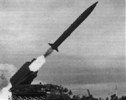 |
| Pluton Missile |
The AN-51 was based on a pure plutonium fission warhead design called the MR-50 CTC (charge tactique commune, or common tactical charge). The MR-50 design was tested 2 July 1966 with a yield of 30 kt, the AN-51 was proof tested 5 June 1971 with a yield of 15 kt. The AN-51 was used to arm the Pluton tactical missile which went into service 1 May 1974. The last AN-51 was manufactured January 1977, the warhead was stockpiled from 1973 to 1993. There were two yield variants - one with a 10 kt yield, and a high yield version of 25 kt. The warhead was relatively light, weighing about 500 kg. A total of 70 warheads were manufactured, one for each of 70 missiles (assigned two to a launcher).
AN-52 CTC Warhead
The AN-52 was France's first tactical warhead, and like the AN-51, was based on the same warhead design - the MR-50 common tactical charge (CTC, charge tactique commune). The AN-52 was a low yield parachute retarded bomb deployed with the Mirage IIIE and the Jaguar A aircraft of the Air Force, and the Super Etendard for naval aviation (Aeronavale). The AN-52 was airdropped 28 August 1972 (yield 6.6 kt). It was stockpiled from October 1972 to September 1991. There were two yield variants - one with a 6-8 kt yield, and a high yield version of 25 kt. The bomb weighed 455 kg, was 4.2 m long, with a body width of 0.6 m (0.8 m fin span). 80-100 bombs were manufactured.
TN-60/61 Warhead
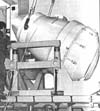 |
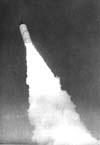 |
 |
 |
| TN-61 Warhead | M4A Missile | MSBS M20 Missile |
This is a family of thermonuclear warheads that began development at least as far back as 1968, when the first developmental nuclear tests were conducted. The first member of this family, the TN-60, was also France's first thermonuclear weapon. The development process was quite lengthy, requiring 21 nuclear tests spread over eight years. The resulting warhead was relatively sophisticated however, similar to U.S. designs of the early sixties such as the W-56 Minuteman II warhead fielded in 1963. The TN-60 was replaced by the improved TN-61 which was lighter in weight and was hardened against nuclear weapon effects. The TN-60/61 family was used to arm both submarine launched missiles (the MSBS M20 and MSBS M4) and land-based missiles (the SSBS S3).
The first TN-60 was transferred from the CEA to the military on 24 January 1976, and effectively entered service in early 1977 when the first SSBN patrol carrying the MSBS M20 missile was made. The TN-60 did not remain in service for long since it was quickly superseded by the TN-61, which entered service late in 1977. Both warheads had a yield of 1 megaton, the TN-61 weighed 275-375 kg (700 kg with re-entry vehicle). The lighter weight of the TN-61 allowed the addition of penetration aids (e.g. decoys) to the RV. Enough TN-60/61 warheads were built to arm four submarines at a time, a total of 64 warheads. A maximum of about 70 warheads total were in stockpile at any given time (to allow for spares). The last TN-61 was withdrawn from naval service in February 1991.
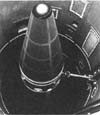 |
| SSBS S3 Missile |
The TN-61 also armed the SSBS S3 missile based in silos on the Plateau d'Albion. The first set of nine TN-61 armed missiles went operational 1 June 1980, and the second set of nine on 1 January 1983. About 20 TN-61s were built for land-based deployment (18 on duty, and 2 spares). The TN-61 was retired from service with the deactivation of the SSBS S3D on 16 September 1996. A total of about 90 TN-61s were manufactured for all purposes.
TN-70/71 Warhead
 |
| M4B Missile |
The TN-70/71 thermonuclear warhead family has lower yield, lower weight, and higher survivability compared to its TN-60/61 predecessor. The smaller warhead size allows the TN-70/71 to be used for arming missiles with multiple warheads (MIRVs). Six MIRV TN-70/71 warheads are used to arm each MSBS M4A and M4B SLBM. Both warheads have a yield of 150 kt. The TN-70 weighs less than 200 kg, the TN-71 less than 175 kg. This makes the TN-71 (stockpiled starting in 1985) roughly similar to the U.S. W-76 Trident warhead (stockpiled starting in 1978) in size and yield.
The development of warheads suitable for MIRV deployment started in December 1972, the first nuclear tests occurred in 1974. The first TN-70 was transferred to the military on 12 July 1983 and went on patrol on 25 May 1985. A total of 96 TN-70s were deployed on a single set of 16e MSBS M4A missiles. In 1985 manufacture of the improved TN-71 began, and the first set of these warheads went on patrol on 9 December 1987. A total of three sets of warheads were deployed (288 on 48 MSBS M4B missiles). Since the total number of M4A/B missiles had declined to 48 by the end of 1996, it may be that the TN-70 has already been removed from service.
TN-80/81 Warhead
The TN-80/81 warhead is a miniaturized, hardened nuclear warhead for the ASMP air-surface missile. The TN-80/81 family is similar to the TN-70/71 in technical sophistication. It is a higher yield warhead though, roughly similar in yield and weight to the U.S. W78 Minuteman III warhead (deployed in 1979). The TN-80/81 has a yield of 300 kt, and a weight of about 200 kg.
Development of the TN-80 may have started as early as 1974, but in any case it was underway before the end of 1977. It became operational on 1 September 1985, and full deployment was reached by December 1987 when all 18 Mirage IVPs were armed. The improved TN-81 was first tested in 1984 and began manufacture in 1987. It entered service 1 July 1988 on the Mirage 2000N, was then deployed on the Super Etendard, and finally replaced the TN-80 on the Mirage IVP in 1991. A total of 65 TN-81s were deployed. All are expected to remain in service beyond 2005.
TN-90 Warhead
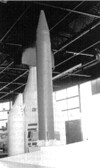 |
| Hades Missile |
This tactical missile warhead was intended to arm the Hades battlefield missile, replacing the AN-51 armed Pluton. The Hades was originally slated to be armed with an enhanced radiation warhead ("neutron bomb") which France had developed in the late 70s/early 80s. Instead the TN-90, a variable yield thermonuclear warhead with a maximum yield of 80 kt was deployed. The TN-90 is equivalent to the U.S. state of the art in this warhead class, and incorporates safety features such as insensitive high explosive. Development began in 1983, series production began in 1990. A total of 30 were built, entering service in 1992. The Hades/TN-90 was never actually deployed to the field. With the collapse of the Soviet Union, President Mitterand declared in September 1991 that the procurement of Hades missiles would be slashed from 180 to 30, and that they would be put in storage as they were built (the only targets reachable from France were in the newly reunified Germany). With the retirement of all French land-based missiles in 1996 the warheads were transferred to storage at Valduc awaiting disassembly.
TN-75 Warhead
Despite its lower number than the TN-90, the TN-75 is actually the last warhead to be developed and proof-tested by France. Completing the proof testing of this warhead was a major motivation for France's final and much criticized test series in the South Pacific. This warhead brings French strategic warhead technology up to par with the U.S. The TN-75 is a highly hardened, miniaturized, safety-enhanced thermonuclear MIRV warhead with a yield of 100 kt. It is a stealthy warhead with a low radar cross section to evade detection and interception. It is being deployed on the new MSBS M45 SLBM, to replace the current MSBS M4B/TN-71 combination. The combination of a lighter warhead and an improved booster provide extended range. This is the only French warhead now in production.




























